Feature Article - An Interview
with John Steven Lasher on Kinopanorama - August, 1999
Staff
![]()

Although widescreen movies were being made in the early part of the 20th century, it was really only after TV threatened movie theater revenues that it took off commercially. We all know about CinemaScope and Panavision, but there was also a very unique and very expensive process that entailed more than one movie camera. Cinerama was one of them, and "How the West was Won" is perhaps the most famous product of that technique. In Russia, cinematographers also developed a three camera process, known as Kinopanorama. While Cinerama is no longer used to make movies, Kinopanorama is. However, it is not in Russia that this process has been revived, nor in the United States where Cinerama began, but In Australia. John Steven Lasher, who produced sound track recordings for "Citizen Kane", "The Best Years of Our Lives", and other films, purchased the rights to Kinopanorama, and is active in using this process to make modern motion pictures. Following is an interview that was made for Secrets' readers.
"The Kinopanorama Experience"
The Soviet three-lens wide screen process known to the Western world as Kinopanorama was relaunched in late 1993 after a hiatus of some three decades. The camera equipment and worldwide rights to the process were purchased by John Steven Lasher, the Australian entertainment executive best known as the producer of many popular film soundtrack recordings (credits include "The Best Years of Our Lives", "The Blue Lagoon", "Citizen Kane", "King Kong", "Sophie's Choice", "Time after Time", among others). Lasher was intrigued by the prospect of producing various genre of films in Kinopanorama (documentaries, short-subjects and advertising commercials) following the 1992 opening of the Pictureville Cinema --at that time the only three-projector equipped cinema anywhere -- at the National Museum of Photography, Film and Television in Bradford, West Yorkshire, England.
 |
| Figure 1. John Lasher restoring the PSO-1960 sound camera at N.I.K.F.I. labs in Moscow. Photo taken on June 28, 1993. |
Derrick Doherty-Pavlik, the pseudonym for an internationally known Sydney film producer, interviewed Lasher for this website.
DDP: What led you to the quest for the 'Holy Grail' of three-lens wide screen systems?
JSL: I thought it a shame that this marvelous process, about which the West knew next to nothing, had passed into oblivion. (Winter Dreams, the final three-lens production, was released in 1963). Obviously, the opening of the Pictureville cinema in Bradford was the catalyst which set me on my search.
DDP: Where did you start?
JSL: The Russian Consulate in Sydney seemed like a good place. The trade representative with whom I spoke had a fond recollection of Kinopanorama films, which he had seen as a child, and thought there might be some chance of locating the equipment in Russia. He recommended Yuri Sokol, a well known director of photography who had migrated from Russia, who he stated was '...the man who can find anything!'.
I rang him up and explained in detail that I planned to re-launch the process if the equipment could be located and restored to working condition.
DDP: Was Mr. Sokol helpful?
JSL: Very much so. Through his many contacts in the Russian film industry a PSO-1960 Kinopanorama sound camera (camera number six), DC- and synch motors, magazines, two sets of lenses (35mm and 50mm), cables and tripod were located in storage, where they had remained for some thirty years.
DDP: What information came back about the condition of the equipment?
JSL: It was restorable. The costs would depend on whether or not I intended to purchase the equipment. I decided to take a gamble. The restoration began in February 1993 under the supervision of Mr. Sergey Rozhkov, an esteemed Russian scientist and inventor, who I was informed had previously been awarded a Technical Oscar by the Academy of Motion Picture Arts and Sciences for his role in the development of new 3-D film technology (StereoVision) in Russia. Obviously, everything was in good hands.
DDP: How long did the restoration take?
JSL: Roughly five months. In August Yuri Sokol informed me that everything was in order, and that the equipment was ready for film tests.
I immediately asked him to fax Russia with instructions to commence filming, which should include shots of those Moscow landmarks best known to Western audiences, before the short Russian summer gave way to crisp Autumn weather and unfavourable lighting conditions.
DDP: What did the Russian crew shoot?
JSL: The Bolshoy Theatre, Kremlin, Red Square, Moscow State University (one of those eponymous 'wedding-cake' Stalinist-Gothic skyscrapers, which are visible from anywhere in Moscow), Russian White House, Sparrow Hills (an excellent vantage point used by newly-wed couples, who traditionally go there to have their photographs taken) and Sheremetyevo II International Airport.
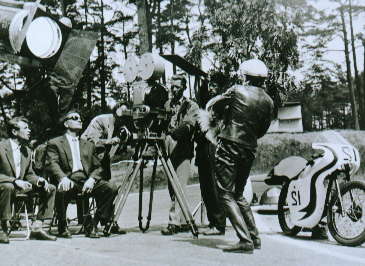
|
Figure 2. "Opasniye Povoroty" filming. Left to right are Kalie Kiisk (Producer), Yuli Koun (Director), Edgar Shtirtzkober (DOP), unidentified focus-puller and clapper-loader. Pieter Scmakov holding dog. |

|
Figure 3. Interior of the PSO-1960 camera film pull-down mechanism. |
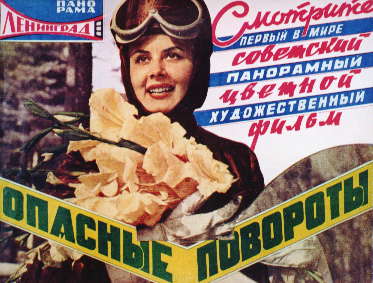 |
Figure 4. "Opasniye Povoroty" cinema lobby card used at Leningrad Kinopanorama cinema. Photo is of Terri Luik holding Gladiola. The Cyrillic script reads, "Experience the first Soviet dramatic panorama film." |
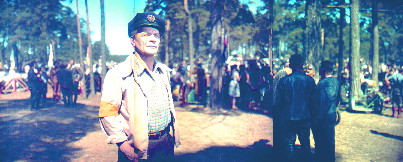
|
Figure 5. "Joyful Racing Corners". Reel 3 of 3-panel color restoration footage printed on Eastman stock from the Sovocolor camera negatives. |
 |
Figure 6. Filming at the Sydney Cricket Ground on December 18, 1994. John R. McLean (Director of Photography). |

|
Figure 7. "Opasniye Povoroty" filming on location in Estonia in 1960. Edgar Shtirtzkober is wearing the beret. The drivers are not identified in this photo. |
 |
Figure 8. Edgar Shtirtzkober (1946-1999), the Director of Photography on "Opasniye Povoroty" at his home in Moscow in 1995 on the 35th anniversary of the film's premiere. |
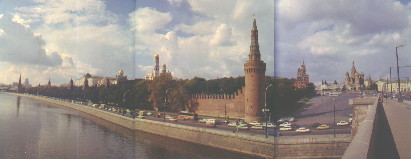
|
Figure 9. "Chastity, Truth & Kinopanorama". Three-panel work-print on Agfa stock from the Sovocolor camera negatives. Kremlin from Bol Moskvoretskiy Most. |
DDP: Why did you choose to shoot at the airport?
JSL: This was a commercial decision on my part. As Aeroflot Russian International Airlines would eventually transport the equipment and crew to Australia, it seemed a good idea to promote their services to Sydney, which was flown by their new A320 Airbus. The Aeroflot management were fantastic in their cooperation. They negotiated access onto the airport tarmac for Sergey Rozhkov and his crew, which included Igor Shevtsov (the director) and Boris Pervukin (cameraperson & clapper-loader) -- something which would have been unheard of in pre-glasnost times.
DDP: Were you happy with the results?
JSL: I was so impressed with the footage, which was screened for us at an outdoor three-projector cinema owned by a private collector, that I personally invited Messres Rozhkov and Shevtsov out to Australia at my expense to assist as our technical liaisons during the initial filming, which was scheduled over some three weeks from mid-November.
DDP: Are there any special prerequisites which the Kinopanorama three-lens process imposes on filmmakers?
JSL: Several. The process, like its Western counterparts (Cinerama and CineMiracle), requires the careful planning of shots beforehand if any number of problems are to be avoided during the shoot.
DDP: Can you be more specific?
JSL: For example, in order to prevent the introduction of parallax and/or vanishing-points where each of the three images overlap and coverage, one must keep the camera absolutely level to the horizon. Another rule-of-thumb -- and one which was often cited by critics as one of Cinerama's major 'defects' -- is to avoid shooting across a continuous line from an angle. Naturally, panning must be kept to an absolute minimum to prevent strobing effects.
DDP: I understand that the PSO-model sound camera includes several advanced features which (at the time) not only set it apart from its American cousins, but was also indispensable to film crews in the accurate blocking and composition of shots.
JSL: Yes, indeed. There is a through-the-lens viewfinder, situated directly below the prime shooting lenses, which is invaluable in this respect, although one must take into account that the actual filmed images are marginally higher.
However, I should note for the record that in their rush to shoot footage of the Kremlin from the bridge at Bol Moskvoretskiy Most and , later, of traffic from an overpass (location unknown) our Russian crew failed to block their shots accordingly. For example, in the former shot (see photo) the retaining walls along the Moscow River 'bend' at the vanishing-points in each panel; in the latter, the automobile traffic below breaks for several frames, disappearing from the 'B' panel before reemerging in the 'A' panel. The two panels appear out-of-sync when in fact they are not.
The end result, of course, was by the time the Russians had arrived in Australia we were able to resolve these matters in full before we commenced our shoot in Sydney.
DDP: I understand that Russian motion picture cameras are milled for K/S (Kodak) 'positive perforation' standards, whereas those manufactured in the West accept only B&H (Bell & Howell) 'negative perforation'.
JSL: You are correct.
DDP: Is this a problem?
JSL: Insofar as to the availability of film stock is concerned I would have to say 'yes'. We are basically limited to only two manufacturers: Eastman Kodak (France) and CBEMA (Ukraine).
The Eastman EXR 5248 colour negative films (ISO 100 Tungsten-rated, which converts to ISO 64 with an 85B filter) must be ordered in advance from Kodak Pathe (Kodak plants in the UK and USA no longer manufacture K/S stock). The minimum order, which is 10,000 feet, takes six weeks minimum to fulfill prior to shipping.
The Moscow footage was shot in Sovcolor, the eponymous Russian tri-pack colour negative film manufactured by CBEMA, because it was readily available to our film crew.
DDP: What was your impression of the Sovcolor stock?
JSL: I must say in all honesty that I quite like it. Of course, it isn't anything like Kodak EXR, with it garnish 'picture postcard' colours. It has a muted colour latitude and renders images which are balanced for European lighting conditions. It is closest in style to the Sgfacolour-Gevacolour film stocks manufactured in Europe the 1950's and 60s. Americans will know that stock as Anscocolor, which MGM used to shoot "Kiss me Kate", "Lust for Life" (shot by Freddy Young, my all-time favourite DOP) and "Seven Brides for Seven Brothers".
DDP: You say that Sovcolor is balanced for European light. How does that translate to Australian lighting, which as we both know is the harshest in the world?
JSL: I thought you'd ask that. The Russians brought 9,000 feet of daylight Sovcolor stock over with them. The ISO speed was, I believe, around 25 -- unheard of in this day and age! We all thought -- Oh dear! -- we are going to have to open the f/stop to somewhere around f/3.5 or f/4, which will pretty much ruin the depth-of-field.
John R. McLean, ACS (employed in 1956 as an apprentice clapper-loader on Cinerama South Seas Adventure in Australia and New Zealand), who alternated with Yuri Sokol as our DOP, was the first to point out that this would present absolutely no problems in Australia. He was correct. We stopped down anywhere from f/5.6 to f/11 on cloudless days; f/4 was rarely used, and only then on dull overcast days.
DDP: Were you able to view the Sovcolor 'rushes' a day or so after filming?
JSL: Unfortunately not. There are no labs in the Southern Hemisphere which stock the old chemicals required to develop these films. All work must be carried out in Russia. The Russian crew took the films back with them, and Sergey Rozhkov couriered the standard light-graded work-prints to me some three or four weeks later.
DDP: Is this reason you've switched over to the Eastman EXR 5248 stock?
JSL: Yes. It's more a matter of time than expenses. Sovcolor might cost considerably less, but one might factor in not only the time lost in transit (Russian customs, I might add, can be notoriously slow in processing outbound shipments), but also the costs associated with the freight, insurance and customs duty.
DDP: When did you first use the Eastman stock?
JSL: Over the1994 Christmas holidays.
DDP: I understand from a previous conversation we had some years ago that this particular shoot, which took place in Dubbo (in rural New South Wales), was fraught with problems. Care to elaborate?
JSL: You know, all filmmakers at sometime or another encounter the proverbial Murphy's Law on film shoots. However, how many of them encounter it in multiples of three, I ask you?
Crisis number one occurred on December 26th, the day I loaded the negatives into the film magazine. This took place in a makeshift darkroom (broom closet) at our local motel. The outside temperature hovered around 40 degrees Celsius (97 Fahrenheit). When I returned to the comfort of my room I discovered to my horror that the Eastman negatives were wound emulsion-side 'in' ,whereas Russian negatives are always wound emulsion-side 'out'. Yuri and I had to abandon that day's shoot of a cricket match between the visiting Zimbabwe team and the locals. After many calls around town we finally found a local cinema where we could rewind the negatives after they closed that evening.
This was a piece of cake compared to what was to follow. On December 27th the camera drive mechanism locked in the heat, due to my failure, for which I must accept full responsibility, to service the camera equipment prior to this shoot after an eleven month hiatus.
It took Yuri Sokol several hours to disassemble and reassemble all the parts on a table in his motel room. I don't know how he did it, but when we turned the motor drive on the camera operated like a dream. Unfortunately, we soon discovered that the film registration pins, which had somehow become out-of-alignment, pinched the film sprockets, resulting in vertical 'jitter' of each frame.
Although this defect was repaired when I took the camera in for its annual maintenance, all of this beautiful footage, including that of native Australian wildlife (Koalas, Kangaroos, Emus, Wombats) shot at the Western Plains Zoo as well as an idyllic bush scene at the historic Dundullimal Homestead, had to be scrapped. (Ed.: these scenes are being reshot in November 1999).
DDP: Have you screened any of this footage for the public?
JSL: In March 1995 I assembled roughly eleven minutes of the Australian footage (including two minutes of the scrapped Dubbo material) for a special screening at the annual Wide Screen Weekend in Bradford, England. It took James Bradley five eight-hour days to edit these work-prints.
DDP: Was this a 'mute' (without soundtrack) print?
JSL: No. Back in October 1994 I had commissioned an original score from my mate, John Charles, whose CD soundtrack albums of "Utu" and "The Quiet Earth" I had previously produced for one of my record labels. John composed two cues, which we recorded on December 18th at Victoria Barracks in Sydney. The seven-track digital masters were transferred to 35mm seven-track magnetic film with an hour or two to spare before I departed for England.
DDP: How was the film received?
JSL: Quite well, actually. The audience applauded after each screening. Frankly, I wasn't at all pleased with this hastily assembled footage. There was a sameness about several of the POV shots, most of which were much too long. Nonetheless, the film at least gave the audience some idea of what the Kinopanorama process is capable of.
DDP: How much have you spent to date on your Kinopanorama projects?
JSL: Over $200,000 out-of-pocket from personal savings and profits from Fifth Continent Music Classics (my music company, which is presently up for sale). This includes the camera restoration, purchase of equipment, sundry repairs, and most pre- and post-production expenses.
DDP: I understand that you've begun script development and pre-production on "I am Australian" and "Our Scenic Wonders", which you intend to release in 2000 and 2001, respectively.
JSL: That is correct. Actually, we've already shot some footage for the latter film in the Blue Mountains, footage which was recently screened for the first time at The New Neon Movies in Dayton, Ohio.
However, I am the first to admit that the amount of work before me requires an inexhaustible amount of patience and fortitude on my part. It is very difficult for independent filmmakers -- particularly those of us producing documentaries -- to secure government funding these days.
For example, when I approached Tourism Australia and the New South Wales Film and Television Office in Sydney for script development funding I was informed in no uncertain terms that although they might be in a position to approve a grant to cover these expenses, Fifth Continent would eventually have to pay off all of it back -- with interest!
The bottom line is that if production on these films is to go forward (as it most definitely will) I am obliged to spend a considerable amount of time 'pounding the footpaths' to secure sponsorship.
DDP: Who do you target?
JSL: I approach those major corporations and private individuals who are known for their commitment to the arts. What I negotiate with the corporations is a provision which includes the allocation of their complimentary ('contras') goods and services in return for the advertising ('product placement') of their product in the film proper. I also factor in whatever ancillary merchandising (videos, compact discs, DVDs, t-shirts, et al) we might subsequently tie to each film's release. This usually works wonders. On the other hand, the success rate as far as I am concerned is far from ideal.
DDP: Has anyone else 'come to the party!'.
JSL: Yes. His name is Bruno Lemonnier, a Frenchman who believes in seeing that the production of new film (and reissues of little-known Kinopanorama classics) is realized. I met him in 1997 to discuss a joint-production arrangement between Fifth Continent Movie Classics and Vision 146 SARL. He outlined the plans for his new company, which included the purchase and restoration of three Cinerama projectors and sound reproducer, equipment which he would use to operate a traveling Kinopanorama cinema in rural France.
I liked Bruno from the start. My gut feeling was that he was definitely committed towards realizing his goals. Moreover, he was willing to put his money where his mouth is! Vision 146 has (to date paid for) post-production (editing, neg matching, printing, sound recording), and which will be followed by the production of show (release) prints, of Chastity, Truth and Kinopanorama (the introductory Kinopanorama trailer (the title, incidentally, is a pun on Sex, Lies and Videotape), which features the 1993 Moscow shoot) and The Kinopanorama Experience (the three projector alignment footage) for release later this year.
DDP: I also understand that you are co-producing the restoration of Joyful Racing Corners (Opasniye Povoroty), the 1961 Kinopanorama sporting comedy filmed in the former Soviet Republic of Estonia?
JSL: Correct. That was one of the first things we discussed. The Russians keep everything -- even if they don't always know where it is. I made an inquiry of my Russian associates about such a restoration. Sergey Rozhkov, after and exhaustive search, located the complete Kinopanorama camera negatives and nine-channel sound masters.
Initially, we both agreed to share the cost to print two reels (roughly 12 minutes at 24fps) of the Sovcolor camera negatives (printed on Eastman stock) along with a newly remastered 35mm soundtrack, which required remixing from nine-tracks to seven on original Russian dubbing equipment, for evaluation before reaching a decision on whether or not to proceed with the complete restoration of the 119 minute film.
DDP: Have either of you seen the test footage?
JSL: Bruno has. He negotiated with Messrs John Harvey (the 'Rolls-Royce of projectionists', in my estimation) and Larry Smith, co-founders of The Cinerama Preservation Society, for a private screening of the prints on Friday, May 28th, at The New Neon Movies, which is officially (for the time being) 'America's only Cinerama theatre'. Bruno flew in from France the evening before.
DDP: I understand that things didn't go according to plan.
JSL: True. Larry Smith forgot that the theatre had already been booked for a school group that Friday. There was no way the prints could be screened that day.
Nonetheless, the end result was a positive one for all concerned. John Harvey and Larry Smith agreed to screen the prints for Bruno and their paying audience, who had purchased tickets for screenings of "How the West Was Won" and "Cinerama Holiday" on Saturday and Sunday, respectively.
DDP: How did things go?
JSL: First off, the colour was excellent. There were some minor synchronization problems (i.e.. 'A' panel was two sprockets out-of-synch in reel one; the soundtrack was 2" out-of-synch in reel two). Fortunately, John Harvey, who cautioned his audience beforehand of such a possibility, has since reported back that these defects can easily be corrected by him before the next screenings, which are 'officially' scheduled for the US Labor Day weekend (September 4th and 5th).
DDP: You previously mentioned that you also couriered some recently shot footage of the Blue Mountains for screening there.
JSL: Correct. Bruno reported back that the work-prints suffered from minor frame 'jitter', which I understand is caused by Australian film labs' step-printers not being set-up for 'positive pref' negatives with six-sprocket pull-down. Previously, no such problems were encountered with those work-prints received from the Russian film labs. It may be necessary for me to use the facilities at Mosfilm Colour Labs for the show prints of all current and future Kinopanorama productions should these 'jitter' problems reoccur when we print up our next shoot.
DDP: When do you both expect to complete the restoration of "Joyful Racing Corners"?
JSL: We have scheduled the international re-release for sometime next year. We hope to premiere the film at The New Neon Movies, followed by screenings at the Seattle Cinerama (as soon as their projectors are up-and-running) and, perhaps, even Pacific Theatres' Cinerama Dome (Hollywood), which is also expected to get the three-projector 'treatment' in mid-2000.
DDP: You've made no mention of Pictureville Cinema in Bradford, England. Why?
JSL: Their management are in the 'dog house' after cavalier treatment towards our offer to screen the test footage of Joyful Racing Corners at the Wide Screen Weekend last March
Bruno and I agree that the Pictureville management will need to demonstrate good faith on their part (which includes payment of exhibition fees) before any Kinopanorama film may be screened there in the future. It would be a shame for them to miss out, but as far as we are concerned this is a commercial enterprise and must be treated as such.
DDP: Any comments for your readers before we 'wrap' this interview?
JSL: I believe that wide screen enthusiasts will no doubt be encouraged by what Fifth Continent Movie Classics and Vision 146 have accomplished in these past six years. Furthermore, I expect that there will be some exciting developments in the new millennium for all concerned.
____________________________________________________________
Notes by Editor (JEJ): After seeing "How the West Was Won" in the early 1960s, I knew that widescreen photography was the way to do movies. Unfortunately, three-camera widescreen techniques are very expensive, and they were dropped in favor of single lens widescreen. One of the questions often asked is wouldn't a wide angle lens have done the same thing as three normal lenses in the first place? The lenses for three-camera (35mm) work are 28mm focal length. To get the same field of view with one lens, it would have to be about 9mm focal length. Such a lens does not exist, except as a "fish-eye" type, which has severe distortion. With three cameras, though, extreme wide angle can be achieved relatively easily. Below is a three-shot picture of the interior of a living room/dining room that I took with a digital camera, successively taking the left frame, then the center, then the right. Then I assembled the three images onto a single frame using digital graphics software. A picture like this cannot be obtained with a single lens.
.jpg)
There are, however, several problems with using three cameras. One is that the overlap between the three images has differences between what they see in the foreground vs. the background. This makes it difficult to line up the three frames when they are projected. One way of getting around this is to align the three cameras so that a tree or corner is at the seam. In the above photo, I aligned the left and center images so that they overlap at the corner of the kitchen counter. The other seam (center and right) is at the left side of the fireplace. I used a small amount of digital manipulation to blend the edges together, and this is one possibility for future three-camera photography, to soften the artifacts produced by image overlap. 3-D graphics programs could be "told" what is in the foreground vs. the background, and the program could perform 3-D manipulation to align the various objects in 3-D space.
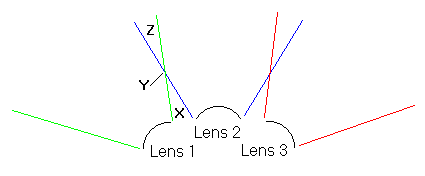 In
the graphic shown at the right, the field of view for three cameras is shown.
Notice that objects at "X" will not be seen by any of the lenses.
Objects at Y will be at the edge of the two lens' field of view (the ideal
location), and objects at "Z" will be seen by Lens 1 and Lens 2.
This makes three-camera photography most suited for scenic images (everything
at great distances from the cameras), but very difficult for objects close up
and including their backgrounds.
In
the graphic shown at the right, the field of view for three cameras is shown.
Notice that objects at "X" will not be seen by any of the lenses.
Objects at Y will be at the edge of the two lens' field of view (the ideal
location), and objects at "Z" will be seen by Lens 1 and Lens 2.
This makes three-camera photography most suited for scenic images (everything
at great distances from the cameras), but very difficult for objects close up
and including their backgrounds.
Three 35mm film frames actually give more picture area than a 70mm film frame. Secondly, lenses made for 35mm cameras have higher resolution than those made for 70mm cameras. This has something to do with the image area that the lens is designed to cover. With a 35mm film, the area is smaller. As a result, even though the 35mm film projected onto the screen does not look as sharp as that from a 70mm film (because the 35mm film is being enlarged more than the 70mm film), the resolution is higher. So, three 35mm film frames projected side by side have the large film space and high resolution. This means that three-camera photography produces a motion picture experience unlike any other.
![]()
� Copyright 1999, where
applicable, Secrets of Home Theater
& High Fidelity
Kinopanorama Logo and Photos in Figures 1-9 are Copyright 1999 Fifth Continent Australia P/L
Return to Table of Contents for this Issue.

